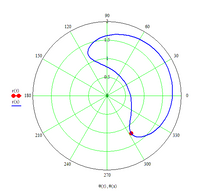Question
The robot moves the particle A (mass M) in the vertical plane using polar coordinate formulas
r (t) = 1.2-0.6sin (2πt) [m]
θ (t) = 0.5-1.5cos (2πt) [rad]
in accordance with
Determine the angular position θ of the arm at time t0 = 1.9 s
Use radians in the calculations, but GIVE ANSWER TO THIS QUESTION IN DEGREES !!
GIVE ANSWER TO THREE DECIMALS

Transcribed Image Text:90
120
60
15
150
30
r(t)
180
r(x)
210
330
240
300
270
A(t), 4(x)
Expert Solution
This question has been solved!
Explore an expertly crafted, step-by-step solution for a thorough understanding of key concepts.
Step by stepSolved in 2 steps

Knowledge Booster
Similar questions
- The angular position of an object that rotates about a fixed axis is given by θ(t) = θ0 eβt, where β = 4 s−1, θ0 = 0.9 rad, and t is in seconds. What is the magnitude of the total linear acceleration at t = 0 of a point on the object that is 2.1 cm from the axis? Answer in units of cm/s2.arrow_forwardWhat is the angle in radians between the vectors a = (-9, 1,-10) and b = (10, -5, -5)? Angle: (rad (radians)arrow_forwarda) What is the period of rotation of Venus in seconds? (The period of rotation of Venus in hours is 5,832.5 hr.) Answer in seconds (b)What is the angular velocity (in rad/s) of Venus? (Enter the magnitude.) Answer in rad/s (c) Given that Venus has a radius of 6.1 ✕ 106 m at its equator, what is the linear velocity (in m/s) at Venus's surface? (Enter the magnitude of the linear velocity at the equator.) Answer on m/sarrow_forward
- 10. Ā = -2â + -3ŷ and B = -4â + -4ŷ. Calculate R = Ã+B. Calculate 0, the direction of R. Recall that 0 is defined as the angle with respect to the +x-axis. A. 49.4° B. 130.6° C. 229.4° D. 310.6°arrow_forwardHello, can you also please include the formula that you used to solve this problem? Thank you!arrow_forwardPoint A of the circular disk is at the angular position 0 = 0 at time t = 0. The disk has angular velocity wo = 0.29 rad/s at t = 0 and subsequently experiences an angular acceleration a = 1.8t where t is in seconds, and a is in radians per second squared. Determine the velocity and acceleration of point A in terms of fixed i and j unit vectors at time t = 2.7 s. Assumer = 145 mm. α Answers: VA = aд = 90 (i ( i 0 6.806 i + i + i i 1 0.705 j) m/s j) m/s²arrow_forward
- An object moves uniformly around a circular path of radius 22.0 cm, making one complete revolution every 2.20 s. ONLY ANSWER C PLEASE, I HAVE A & B (a) What is the translational speed of the object?0.628m/s(b) What is the frequency of motion in hertz?0.454Hz(c) What is the angular speed of the object?rad/sarrow_forwardDeduce an expression for a rotation operation along z-axis R₂(a)= exp. La ħarrow_forwardA yoyo of radius R and mass M is released from rest with the string vertical and its top end fixed up a support as shown below. How fast is the center of mass of the yoyo moving when it has fallen a distance of 47 cm. Ignore the mass of the string and express your answer if m/sarrow_forward
- please do part carrow_forwardAt the local swimming hole, a favorite trick is to run horizontally off a cliff that is 5.82 m above the water. One diver runs off the edge of he cliff, tucks into a "ball," and rotates on the way down with an average angular speed of 1.83 rev/s. Ignore air resistance and etermine the number of revolutions she makes while on the way down. Number 1.99 Units revarrow_forwardAn astronaut is being tested in a centrifuge. The centrifuge has a radius of 9.10 m and, in starting, rotates according to θ = 0.390t2, where t is in seconds and θ is in radians. When t = 2.60 s, what are the magnitudes of the astronaut's (a) angular velocity, (b) linear velocity, (c) tangential acceleration, and (d) radial acceleration? (a) Number Enter your answer for part (a) in accordance to the question statement Units Choose the answer for part (a) from the menu in accordance to the question statement radrad/srad/s^2kg·m^2N·mkg·m^2/srad^2/s^2 (b) Number Enter your answer for part (b) in accordance to the question statement Units Choose the answer for part (b) from the menu in accordance to the question statement This answer has no units° (degrees)mkgsm/sm/s^2NJWN/mkg·m/s or N·sN/m^2 or Pakg/m^3gm/s^3times (c) Number Enter your answer for part (c)…arrow_forward
arrow_back_ios
SEE MORE QUESTIONS
arrow_forward_ios